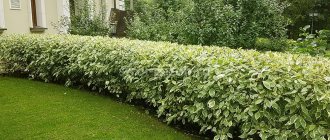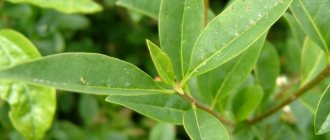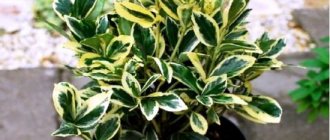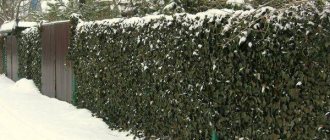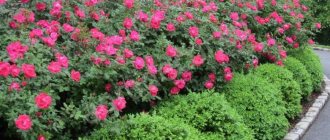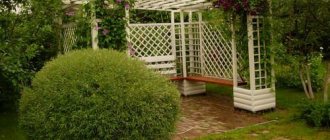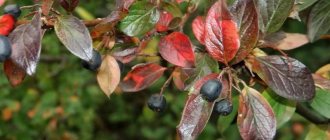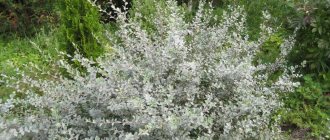Scope of work
What is included in the services
- Molded hedges are trimmed 2-3 times per season, but deciduous hedges are cut once in the first year, and coniferous hedges begin to be cut only in the second year due to their slower rooting.
- Free - growing hedges are not trimmed. Stimulating, light trimming, sanitary pruning is applied to them.
- The advantages that hedge trimming gives us: - clarity of hedge lines that define its profile; - getting rid of slow or too fast growth; — getting rid of insufficient density of branches and thinning of the crown; — increase in root growth; — plant rejuvenation; - garden decoration.
To maintain the thickness and density of a hedge, there is no need to “spar” it when cutting it. To prevent thinning of the crown, loss of strength and external aesthetic appearance, the crown must be trimmed as close as possible to the previous trimming
Borisova Maria (landscape architect)
What should the borders be like?
Low hedges and borders of plants are created on the site to highlight certain areas. This could be the entrance or a path in the garden, or a flower garden, a lawn. In any case, a border or a low hedge is already a separate element of landscape design. Basic requirements for this element:
- density;
- limited growth;
- tolerance of molding haircuts;
- unpretentiousness.
The small height of the curb does not mean that it will take little time and effort to maintain. It's not like that at all. Labor costs will be almost the same as when caring for an ordinary hedge, especially since they are planted from young seedlings in any case.
Of course, in addition to the necessary characteristics listed above, plants for the border must be decorative.
The following plants have all the necessary qualities:
- bloodroot;
- mahonia holly;
- low-growing barberries;
- caragana;
- Fortune's euonymus;
- gorse;
- spirea;
- quince.
Despite the fact that currants and gooseberries are rarely used as hedges and borders, they can be adapted to this.
Among the low-growing barberries, boxwood barberry can be noted. This is an evergreen plant that looks very beautiful in a hedge, in addition, it can also be used for landscaping balconies and terraces. It is able to grow in the sun and in partial shade, prefers sandy and sandy loam soils, and withstands shearing well.
Euonymus Fortune variegated
Fortune's euonymus varieties are also suitable for low hedges. This plant grows slowly, the shrub can be called creeping for its long vines, which appear in the absence of molding trimmings. The advantage is that they root well, so there will be no problems with planting material. The variegated forms of Fortune's euonymus are especially decorative. Partial shade is optimal for this plant.
Caragana shrubby
Caragana is often called acacia, but this is not at all correct. Caragana shrub can also be used for a low hedge, if you constantly monitor its growth, otherwise this shrub, especially its thorny species, can create impregnable thickets. Caragana plantings are loose, but will feel good on any soil, even in the absence of constant watering. To subordinate the caragana to your design, you need to frequently subject it to molding pruning, which it tolerates normally.
Cinquefoil Dahurian
Dahurian cinquefoil is a shrub up to 1 m high. Delicate white flowers can be seen on this shrub all summer. Cinquefoil is unpretentious, loves the sun, is content with minimal watering and fertilizing, and is well trimmed.
Spiraea is a real find. There are different types of spirea, the shortest of which can limit the intended space with their bushes. Taller spireas can appear as a hedge up to half a meter. This plant is unpretentious and tolerates heat and molding. Separately, it should be noted that spirea is decorative - different types boast flowers of different shapes and shades. The main rule when planting spirea is the absence of stagnation of moisture.
Mahonia holly
You should pay attention to holly mahonia, which is good because it is an evergreen deciduous shrub. Mahonia has peculiar leathery leaves, which it flaunts even in winter. In the middle zone, mahonia is covered in the absence of snow cover. Mahonia prefers moist areas, partial shade or shade. It is important to limit the growth of mahonia hedges by timely cutting.
In dry areas, gorse is planted as a border. It grows even on depleted soils. Its vertically directed shoots are covered with narrow leaves, and the shrub blooms with yellow flowers. When frozen, gorse recovers quite well.
Japanese quince is another option for a low element of site decoration. This is a plant with a dense crown and beautiful flowers, in place of which fruits with a lemon taste appear. The quince must be protected from the wind, so the choice of site for its planting should be taken responsibly.
Ordinary currants and gooseberries can also be cultivated as a hedge, you just have to plant them more densely and trim them. But the best option would be to use alpine currants for these purposes. This is the type of currant that is the most unpretentious. She prefers open areas and is not picky about soil composition. But the berries of such currants, firstly, are tasteless, and secondly, they will require planting plants with male and female flowers, since alpine currant is a dioecious plant.
Plants for borders planted taking into account their preferences, otherwise the result may not meet expectations at all.
An article on growing viburnum buldenezh can be read here.
If you find an error, please select a piece of text and press Ctrl+Enter.
PRICE LIST
| Services list | Unit measurements | Price, rub.) |
| Consultation with a specialist in the company’s office for up to 1 hour | for free | |
| Consultation with a specialist in the company’s office for more than 1 hour | 1,500 rub./hour | |
| Visit of a specialist to the site (Moscow and Moscow Region up to 50 km) Primary analysis of the condition of the site, photography. | 5,000 rub. | |
| Departure of a specialist to the site (Moscow Region more than 50 km) Primary analysis of the condition of the site, photography. | negotiable | |
View the full price list of landscape services
Call us
tall plants
If you want a hedge 3-5 meters high, plant shrubs that will reach this height in 2-3 years. But purchase a ladder in advance to trim the hedge from above; many shrubs will tend to outgrow the specified height.
Thuja
This plant belongs to the cypress family. A thuja hedge can grow up to 20 m high. The plant tolerates pruning well and can be cut into garden shapes. In addition, thuja fills the air with beneficial phytoncides.
Privet
Cone-shaped shrub growing up to 3 meters in height. In July it blooms with light cream flowers, after which black berries are formed on the branches that do not fall off all winter. The shrub tolerates pruning well and is suitable for forming various shapes.
Aronia chokeberry
The shrub grows up to 3 meters tall. It has white or pink flowers. Aronia berries are edible and very healthy; they contain a lot of ascorbic acid. The plant does not need frequent pruning
Tall lilac
The shrub can grow up to 5 m in height. It is not recommended to plant on the border of the plot; neighbors and passers-by will harm the plant by breaking off branches with flowers in May. And if he plants a lilac hedge inside the territory, this purple flower will become
Elder
The undoubted advantages of elderberry are its fragrant flowers and healthy berries. There are two subspecies that grow well in height - red and black elderberry. This plant does not require care.
Question answer
Do you provide a guarantee for your work?
Yes, we do. One (1) year for all plantings and three (3) years for construction work during our garden maintenance.
How much does site maintenance cost for your company? Do you have gardeners?
Our company includes a full staff of landscaping personnel, including gardeners. Find out about the conditions and prices for garden care.
Do you provide on-site consultations on the condition of the garden?
Yes, we do. For more detailed information, please call +7 or +7 (916) 803-13-54 .
Do you design low-maintenance gardens?
Yes, we are designing. Only most likely it will be close to the natural style. You can read more about this here.
View entire FAQ
Purpose of the fence
Before choosing plants, answer yourself the question - why do you need a fast-growing perennial hedge?
- To divide a site into zones of different purposes or designs;
- For planting a low decorative border along garden paths;
- Separate part of the garden from prying eyes, create a place for privacy;
- Create a play labyrinth for children;
- Separate the inside of the yard from the outside;
- Create a green alternative to a fence, fence off the area from street noise, flying dust and curious glances of people passing by.
How should she look?
- Geometrically smooth green wall with right angles;
- Trees and shrubs with crowns of natural shape;
- Uneven hedge with height differences around the perimeter;
- Constantly blooming, from early spring to late autumn.
In each case, the choice of shrubs or trees for planting will be different. A hedge to protect the area from strangers, as well as a fence that should bloom all season, are planted in several rows.
Stages of work - Trimming hedges
Free consultation
You can get advice on trimming hedges on your property by calling | +7 (916) 803-13-54
Site inspection
If necessary, go to the site, familiarize yourself with the site, collect the necessary information and discuss wishes with the Customer.
Preparation of estimates
The cost of the service is determined by the height, complexity of design, length, “filling” and number of tiers of green fencing.
Signing the contract
Concluding a contract for hedge trimming work on your property
Hedge cutting work
Hedge trimming according to the layout.
The timing of the work varies depending on the volume, area of landscaping, season and is discussed individually. Free consultation with a specialist
Get a response within 15 minutes
What plants are best to plant for a living border?
Initially, the owner of the territory needs to decide whether to plant deciduous or evergreen varieties. Accordingly, what does the owner want to see on his property: a neat green fence or does he not care that bare trunks stick out.
Barberry Thunberg "Bagatelle" is a deciduous shrub that belongs to a slow-growing subspecies. Foliage of purple and crimson shades forms a spherical dense crown, growing no more than 2-3 centimeters per year. Flowering is abundant, starting from June – July. Delicate yellow flowers grow individually or form small inflorescences. Afterwards, approximately in October, bright red oblong berries, edible, are produced. The bush loves sunlit places, but is able to grow in partial shade. It tolerates drought and heat well, and is undemanding to the composition of the soil. Only undeveloped young trees need to be pruned, and old shrubs are thinned out with the onset of spring. Watering should be done moderately, as barberry does not tolerate stagnant moisture. Young seedlings need to be covered with spruce branches during the winter.
Barberry Thunberg "Kobold" is an elegant plant whose crown has an emerald green hue, changing to orange-yellow in the fall. The short shoots of the bush are very short, curving. The foliage is ovoid, not exceeding 1.5 centimeters in length. “Kobold” is also distinguished by the presence of thorns on its branches. It blooms in May, in small inflorescences, and the diameter of one bud is no more than 1 centimeter. The petals are yellow on the inside and red on the outside. Fruits profusely with pinkish or bright red edible berries. It is better to plant in sunny parts of the plot of land. Unpretentious to the composition and acidity level of the soil. It is imperative to feed the bush during the growing season with mineral fertilizers. Withering, dried shoots should be dried out in a timely manner. It survives freezing temperatures well. Very resistant to disease and pest attacks.
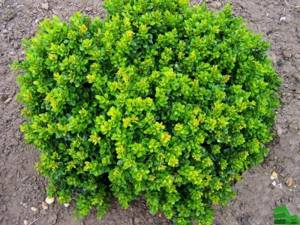
Spiraea japonica "Golden Princess" is a deciduous shrub variety that grows to a height of about 50 centimeters. The lush cannon-shaped crown grows up to 1 meter in diameter. The foliage first grows in a bright yellow color, which later becomes calmer, more saturated, and closer to autumn it acquires an orange or red tint. Flowering occurs at the end of June and is accompanied by pink corymbose inflorescences, where the flowers reach up to 5 centimeters in diameter. Frost-resistant plant preferring illuminated places. Spiraea is unpretentious to the type and composition of the soil, but develops better under conditions of sufficient moisture, looseness, and fertility. Mechanical processing should be carried out in the spring, cutting off the bush so much that only 15-20 centimeters are left from the ground. In the summer, it is necessary to systematically dry out fading flowers in order to maintain the decorative condition of the bush.
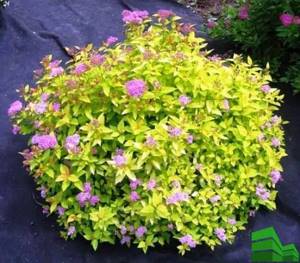
Fortune's euonymus is a low-growing species of vegetation. It differs in that it spreads along the surface of the ground, and the shoots retain foliage all year round. The leaves themselves are oval, elongated, green with a yellow edge. It grows to a height of 30 centimeters to 2 meters, regulated by cutting. Grows best in light shade or diffuse lighting. However, in shaded parts of the site the leaves will not be as bright. Euonymus should be fed in the spring. A relatively undemanding plant with a good growth rate. With proper regular care, it develops well and looks more decorative. It is necessary to water moderately, as the bush does not tolerate stagnant moisture. In this regard, it is recommended to drain heavy soil.
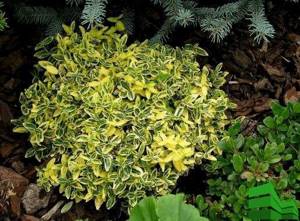
Dwarf caragana , also known as low-growing acacia, is distinguished by its frost resistance, excellent tolerance to dry periods, and good growth even in urban conditions. This vegetation is light-loving, growing from 0.3 to 1.5, and sometimes up to 2.5 meters. The height of the bush is adjusted by pruning. It blooms with bright yellow flowers throughout the summer and bears fruit abundantly. Euonymus berries are inedible for humans, but birds happily consume them. Reproduction is carried out by the seed method, but there is one caveat: the seeds are planted after collection. If everything is done in a timely manner, you can expect the first shoots in the fall of this year or spring of next year. The upper parts of young animals are prone to freezing, so they should be covered throughout the winter. It is recommended to plant in those parts of the territory where there is no through cold wind.
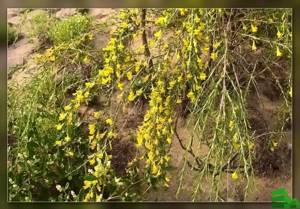
Small-leaved boxwood is a cold-resistant shrub native to Japan and China. Reaches a height of no more than 1.5 meters. The crown is formed from leathery leaves of a wide oval appearance, growing from 5 to 25 millimeters. The flowering period begins in spring with lush inflorescences consisting of small whitish flowers with a strong, pleasant aroma. Boxwood is planted either early in the spring in order to obtain a flowering appearance by the fall, or already in the fall, but then the decorative structure will appear only by the spring of next year. The seedlings need to be immersed into the soil during the second part of September, but before the beginning of October: the plant needs about four weeks to strengthen so that it has enough strength to survive the winter. Experienced gardeners recommend choosing partial shade or shade on the site for planting boxwood. This is associated with a greater risk of light damage to foliage from the sun.
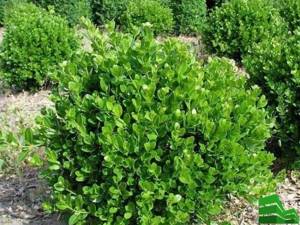
Hybrid cotoneaster “Coral Beauty” is a representative of evergreen low-growing bushes. It has a high crown density and grows on any type of soil. Reaches a length from 40 to 150 centimeters. The foliage is small, bright green. Flowering occurs luxuriantly, with small white flowers. It bears fruit abundantly with bright red spherical berries that do not fall off for a long time. Cotoneaster is unpretentious to the type and composition of the soil, preferring bright places with little shade. It survives freezing temperatures and frosts, but most often frosts severely damage the bush. But the plant is doing well and will rehabilitate itself soon enough. The vegetation is resistant to attacks from pests and diseases.
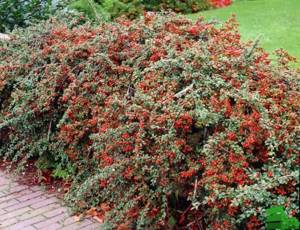
Gorse is a low-growing shrub with very decorative flowering, growing 20-150 centimeters. There are semi-evergreen and deciduous subspecies. The crown consists of small leaves of a simple or trifoliate type without or with an edge. Gorse flowers are bright golden in color and resemble peas; they form small racemose inflorescences or heads. The small, flat berries contain many seeds. The root system of gorse is quite compact, which allows it to be planted both on the site and in the house. Unpretentious to soil, tolerates drought well. Propagated by cuttings or seeds. The ground part of the bush is slightly poisonous, which is due to the presence of alkaloids, but some species are classified as medicinal plants.
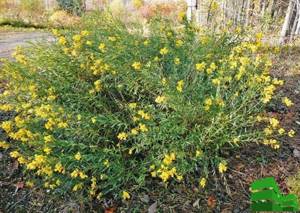
Holly-leaved Mahonia belongs to low varieties of bushes; it grows only up to 1-1.5 meters. This feature makes mahonia an excellent choice for decorating garden paths and creating low-growing hedges. The bush itself consists of many shoots, tightly adjacent to each other. As a result, a compact, dense crown is created, and the foliage retains its decorative characteristics throughout the year. Large leaves with a shiny surface reach a length of 20 centimeters. It blooms with large racemose or paniculate inflorescences from April or May. The flower petals themselves are small and have a rich lemon hue. At the end of summer or early autumn it bears fruit with oblong berries of a dark blue color with a bluish bloom, suitable for consumption. Wine is also made from mahonia fruits. Propagated by seeds, cuttings and layering.
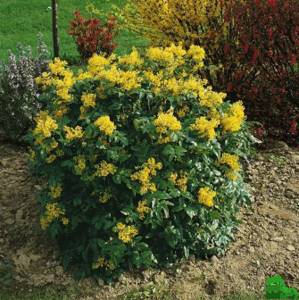
Cinquefoil is a perennial low species, but there are also biennial and annual subspecies. It grows 8 centimeters. The short, thin stems are almost bare at the bottom. The flowering period falls from May to October and is accompanied by the development of umbrella-shaped or panicle-shaped inflorescences in white, yellow, pink or red shades, where each flower has four or five petals. Afterwards, the cinquefoil bears berries, which consist of achenes. The achenes are mostly bare and only in some varieties are covered with hairs. The average number of achenes is ten.

Stock
Until the end of the promotion
More details
Until the end of the promotion
More details
Until the end of the promotion
More details
Popular services
- Landscaping and improvement project
- Design of drainage and stormwater systems
- Order a dendroplan of the site
- Planting trees on the site
- Turnkey lawn installation
- Landscape lighting
- Construction of ponds and reservoirs
Interesting
- Landscape Design Styles
- Landscape design articles
- Landscape design photos
- Promotions and special offers
- How the price for services is formed
- Work plan and stages
- Questions and answers (FAQ)
How to trim and shape bushes
To trim and shape decorative deciduous shrubs (for example, viburnum, lilac, hazel), they are trimmed with pruning shears a year after planting. Primary pruning is carried out in the spring, at a height of 30-40 cm from the soil. In the future, crown shape correction is required twice a year.
For living fences, climbing annuals and perennial vines (wild grapes, tea rose bushes, ivy, etc.) are also often used. Plants branch quickly, so regular formation is required. Use scissors or pruners. They form plants, creating arched complexes, and shade gazebos and fences with them. Roses and grapes are pruned in the fall. Hops and ivy vines should be trimmed in early spring.
Features of the formation of plants, more often than others used in the creation of living fences:
- Privet. In order to form a shrub with a beautiful crown, it needs to be pruned regularly from the 2nd year of planting. In modern landscape design, semicircular, spherical, and cubic shapes are cut. Trim with a lopper and pruning shears. As a result, flowering decreases, but the growth of branches and foliage increases.
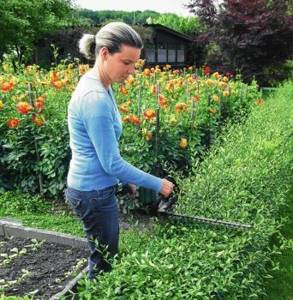
For the first time, more than ½ of the shoots on privet are cut off, and subsequently - up to 70% of the growth.
- Spirea. Pruning depends on the plant variety. Bushes that form flowers on last year's branches cannot be cut back every year. Trim the plant after flowering, to the root. In spring - remove up to half the length of the branches. Other varieties require careful annual cleaning. Branches are cut back to the first bud in spring.
- Hawthorn. There is no need to trim the hawthorn hedge very low from the soil; this still will not help get rid of the exposed trunk. Pruning is carried out once a season. The lower branches above the pronounced bud are removed. Young shoots are allowed to grow, and then they are also cut off.
- Thuja. The plant responds well to pruning and quickly develops new shoots. The hair is cut for the first time in June, when the shape is set. Correction is carried out in mid-summer. The width of the top of the living fence should be narrower than its base.
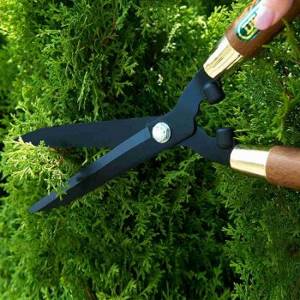
Young thuja shoots up to 0.5 cm thick are cut using special scissors.
- Spruce. Form a spruce hedge in the spring. In order for the planting to have a beautiful appearance, it is necessary to restrain the growth of spruce. Pruning allows you to make the hedge fluffy and moderately tall. It also helps to give the crown its original shape.
For a novice landscape designer or gardener, trimming a hedge evenly can be difficult. Special templates are used, made from a thick cardboard sheet or fiberboard (an opening of the desired shape is cut out in the sheets). You can also use an elementary folk method to ensure that the pruning result is flawless.
